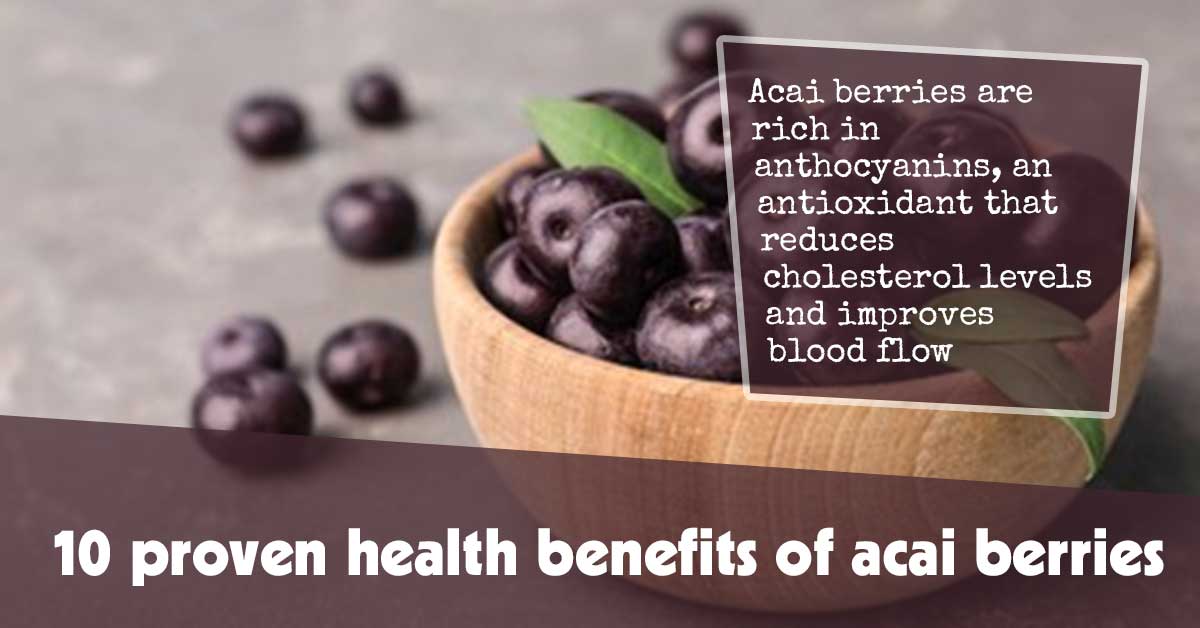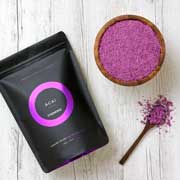Ready for a fun trip to the lush rainforests of South America? That’s where you’ll find acai palm trees, showing off their cool little purple berries called acai berries.
These tasty treats have become super popular, and for good reason! They’re packed with antioxidants and offer tons of health benefits.
1. Improve heart function
Acai berries are rich in anthocyanins, an antioxidant that reduces cholesterol levels and improves blood flow.
According to a pilot study, junior athletes who drank a juice blend made from acai berries every day for six weeks showed improved blood antioxidant levels, less muscle damage from exercise, and better serum lipid profiles.1✅ JOURNAL REFERENCE
DOI: 10.5604/20831862.1144419 These findings indicate that acai berries could be beneficial for cardiovascular health.
Acai Powder
- Organic Ingredients
- Vegan Friendly
- NON GMO Ingredients
- Naturally Gluten Free
- Naturally Soy Free
- Naturally Dairy Free
2. Aid in weight loss
Acai berries have fiber, which can promote satiety and decrease calorie consumption. Additionally, they may assist in reducing body fat, resulting in weight loss.
A study suggests that acai pulp or berries can help prevent memory and cognitive impairment caused by a high-fat diet in mice.2✅ JOURNAL REFERENCE
DOI: 10.1080/1028415X.2022.2158931 The study found that consuming acai pulp improved insulin sensitivity, indicating that acai berries may aid in weight loss.
While more research is needed, incorporating acai berries into a healthy diet and exercise routine can help with weight loss efforts.
3. Promote digestive health
Since acai berries are high in fiber, they promote digestive health by regulating bowel movements and reducing constipation. Polyphenols present in acai berries possess anti-inflammatory characteristics that may help guard against digestive ailments.
In a study of patients with ulcerative colitis, supplementation with acai berry pulp led to reduced disease activity and improved quality of life.3✅ JOURNAL REFERENCE
DOI: 10.3390/nu15040989
4. Boost immunity
Acai berries are loaded with antioxidants such as anthocyanins and vitamin C that can enhance the immune system and safeguard against infections. These antioxidants neutralize free radicals that cause cellular damage and compromise immunity.
Acai berries also have antimicrobial compounds that can combat bacteria and viruses. Research has found that acai pulp supplementation increased the production of specific immune cells in healthy volunteers.4✅ JOURNAL REFERENCE
DOI: 10.1371/journal.pone.0017301
Additionally, acai berries contain beta-glucans, a fiber that improves immune function and reduces the risk of infection.
5. Improve cognitive function
Acai berries contain several compounds that may improve cognitive function and protect against age-related cognitive decline. Acai berries are abundant in polyphenols, which are known to have neuroprotective effects that could potentially reduce the risk of Alzheimer’s disease.
They also contain omega-3 and omega-6 fatty acids, which are crucial for brain health and may help enhance cognitive abilities.
A lack of these fatty acids has been linked to cognitive decline and neurological disorders. They are important for building and maintaining the membranes of brain cells.
Acai Powder
- Organic Ingredients
- Vegan Friendly
- NON GMO Ingredients
- Naturally Gluten Free
- Naturally Soy Free
- Naturally Dairy Free
6. Anti-inflammatory properties
Acai berries are packed with powerful antioxidants called anthocyanins that help fight inflammation. These antioxidants neutralize free radicals and reduce oxidative stress, which can lead to long-term inflammation.
Plus, acai berries have other inflammation-fighting compounds like flavonoids and proanthocyanidins. Eating acai berries regularly as part of a balanced diet can help keep inflammation in check and lower the risk of related health issues.
7. Reduce risk of cancer
Acai berries contain compounds that may have anti-cancer properties and reduce the risk of certain types of cancer. One study found that acai berry extract reduced the growth of human leukemia cells in vitro. Acai berries are also high in polyphenols, which have anti-cancer properties.5✅ JOURNAL REFERENCE
DOI: 10.1371/journal.pone.0200101
Moreover, acai berries contain beta-sitosterol, a plant sterol that has anti-cancer effects in vitro and in animal studies. But with that said, more research is needed to determine the potential anti-cancer benefits of acai berries in humans.
8. Improve skin health
Acai berries have antioxidants like anthocyanins, flavonoids, and vitamin C that can protect the skin from oxidative stress and inflammation. In animal studies, these chemicals have been shown to make the skin more flexible and less wrinkled.6✅ JOURNAL REFERENCE
DOI: 10.1111/ics.12848
Aside from their antioxidant properties, these berries contain compounds that may help protect against UV damage, a major contributor to skin aging and skin cancer.
One study found that acai berry extract reduced the growth of skin cancer cells and protected against UV-induced DNA damage in vitro.7✅ JOURNAL REFERENCE
DOI: 10.3390/antiox9060542 You can use this extract as part of your skin care routine to help keep your skin healthy and looking young.
9. Regulate blood sugar levels
Acai berries may help regulate blood sugar levels, which is vital for reducing the risk of diabetes and improving overall health. A study found that metabolic syndrome, a condition with various risk factors for heart disease and type-2 diabetes, may be influenced by reducing harmful molecules called reactive oxygen species.8✅ JOURNAL REFERENCE
DOI: 10.1186/1475-2891-10-45 Acai berries could potentially normalize the pathways involved in this syndrome.
These berries contain compounds that may help prevent spikes in blood sugar levels by reducing glucose absorption from the diet. This is particularly beneficial for individuals with insulin resistance or type 2 diabetes.
10. Improve exercise performance
Acai berries contain compounds that may improve exercise performance by reducing muscle damage and increasing energy levels. Polyphenols present in acai berries have anti-inflammatory properties that may help in reducing muscle damage and soreness following exercise.
One study found that acai pulp supplementation improved physical performance and reduced muscle damage in trained athletes.9✅ JOURNAL REFERENCE
DOI: 10.5604/20831862.1144419 Acai berries are also rich in carbohydrates and other nutrients that can help increase energy levels and support athletic performance. Adding these berries to your diet before you work out may help you perform better and feel less sore afterward.
Acai Powder
- Organic Ingredients
- Vegan Friendly
- NON GMO Ingredients
- Naturally Gluten Free
- Naturally Soy Free
- Naturally Dairy Free




